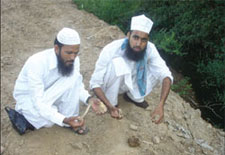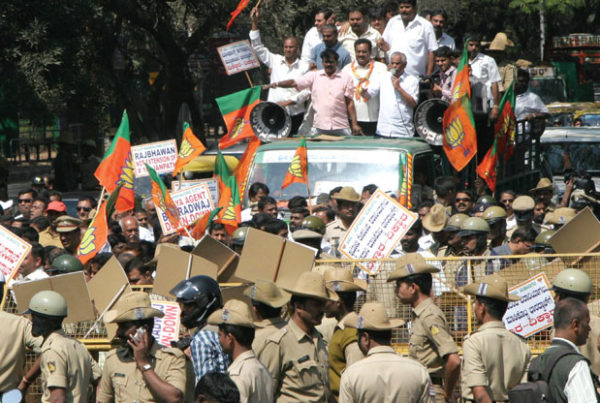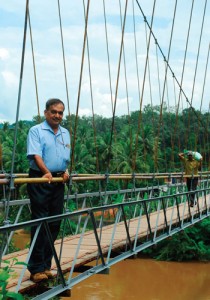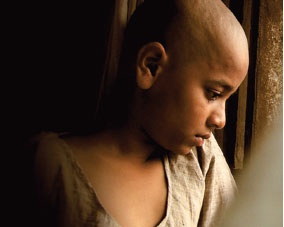CENTURIES-OLD GRAVEYARDS DEMOLISHED BY THE STATE
Now, anti-Muslim prejudice in polarised Gujarat extends six feet under, reports Sanjana Chappalli
 ON OCTOBER 3, Ajaz Khan Pathan, a resident of Dahod – a quiet town located 200 km from Gujarat’s commercial capital Ahmedabad – decided to pray at his ancestors’ graves. The 250-year-old graveyard at Idgah Chaab Talav had always filled him with calm. Pathan also wanted to clean the graves and lay flowers on them. Nothing could have prepared him for what he saw when he came to his destination, which lies a few metres off Dahod’s main road. A frenzied mass of labourers, bulldozers and excavators had been set loose on Pathan’s oasis of tranquility. The work crew was busy digging up graves and levelling the land. Bricks, rubble and even bones that had lain undisturbed for hundreds of years lay scattered across the raw earth.
ON OCTOBER 3, Ajaz Khan Pathan, a resident of Dahod – a quiet town located 200 km from Gujarat’s commercial capital Ahmedabad – decided to pray at his ancestors’ graves. The 250-year-old graveyard at Idgah Chaab Talav had always filled him with calm. Pathan also wanted to clean the graves and lay flowers on them. Nothing could have prepared him for what he saw when he came to his destination, which lies a few metres off Dahod’s main road. A frenzied mass of labourers, bulldozers and excavators had been set loose on Pathan’s oasis of tranquility. The work crew was busy digging up graves and levelling the land. Bricks, rubble and even bones that had lain undisturbed for hundreds of years lay scattered across the raw earth.
Several hours later, Pathan and his friends learnt that the Dahod Municipal Corporation (DMC) authorities had decided that the town needed a new road – a road, as it turned out, that would cut right through a section of the graveyard. There had been no prior notice given to anyone. Dahod is easily one of Gujarat’s most backward districts and over the years, its backwardness has become an easy answer for a range of questions, be they on funds for education or relief for riot victims. When Khan and other Muslims asked why the graves of their forefathers had been desecrated, DMC President Gulshan Bachani (of the BJP) claimed that the road was necessary to develop Dahod – and lift it out of its backwardness.
Says Khan, “We waited for five days before being granted a meeting with Bachani. We would go every day, see him in his office, but return without a meeting. Meanwhile, the graveyard continued to be levelled. When we were finally granted an audience on October 8, the president was firm in his claim that the road was necessary for Dahod’s development.” Khan and others say that Bachani refused to discuss details of the project with them but only told them repeatedly that it would increase traffic into the town and hence bring development to the region – an explanation they reject. “We are convinced this is another way to inflict violence on Muslims. They knew the graveyard is an ancient one and that it would be sacrilege to dig up graves and disturb the bones of our ancestors. But none of this matters to them at all,” says an emotional Farooq Bhai Patel. “They tried to kill us all in 2002. The ones who survived are being killed in a different way now,” he adds bitterly.
Patel is a fruit merchant in Dahod and, along with Pathan and others, is a member of the Dahod Muslim Panch – an organisation that has been working to uphold the rights of the Muslim community after the 2002 riots.
UNFORTUNATELY, THE facts appear to substantiate the Panch’s charge of anti-Muslim prejudice. In an extensive interview with TEHELKA, DMC President Bachani admitted that the road project was a scheme approved in 1977 and could give no conclusive answer to why a 32-year-old plan was being revived. He also failed to explain just how the Rs 50 lakh road project sanctioned under the Tribal Sub-Plan (a government scheme for tribal development projects) would benefit the tribal community. Bachani would only repeat throughout that, “The road will improve connectivity.” And just how much of the graveyard will the road project take up? Shockingly, Bachani admits that he has no idea, because the project construction — and graveyard desecration — started without a proper survey being completed.
‘HOW CAN YOU COMPARE TEMPLES AND GRAVEYARDS? TEMPLES ARE FULL OF THE LIVING; GRAVEYARDS ARE FULL OF THE DEAD. WHO CARES ABOUT THEM?’ SAYS THE DMC PRESIDENT
The story of Chandvada, about 60 km from Tilakvada, is even worse. The local Muslims have had their graveyard turned into a cattle pasture, with dung and haystacks scattered across it. Attempts by Muslims to explain that the graveyard was a sacred place have been completely disregarded by local Hindus. In conversations with TEHELKA, both communities held the other responsible for the situation as it existed currently.
Activists like Harsh Mander and Shabnam Hashmi who have been working in Gujarat for several years believe that the destruction of graveyards is yet another manifestation of rampant communalisation in the state. Explains Mander, whose recent book Fear and Forgiveness: The Aftermath of Massacre tracks the ongoing discrimination in Gujarat after the 2002 riots, “These are decentralised efforts, really; methods devised at local levels to constantly remind Muslims of their second class citizenship.” For Hashmi, the issue was even more distressing since it highlighted the utter disregard for the judiciary. Said Hashmi, “With police and government officials batting on the same side against Muslims, the situation is bleak. People like us who constantly attempt to highlight the continuing violence are now looked at askance or threatened with violence ourselves.”
—
This article was originally published in Tehelka, a leading independent news magazine in India, known for its investigative journalism.



